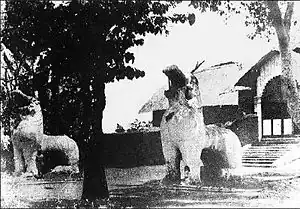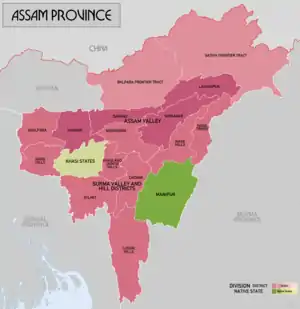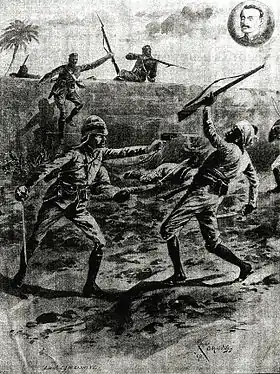Anglo-Manipur War
The Anglo-Manipur War[5] or Manipuri Rebellion of 1891 was a short armed conflict between the British Colonial Forces and the dissenting royal princes of Manipur Kingdom, which was arguably a dependency of the British Empire in India. The conflict began with a palace coup staged by the general (Senapati) of Manipur, ousting its reigning king, and installing a half-brother in his place. The British government took objection to the action and attempted to arrest the general. The effort failed, with the Manipuri forces attacking the British residency and the resident and other British officials getting executed. The British launched a punitive expedition that lasted from 31 March to 27 April 1891. The general and other rebels were arrested and convicted. The British annexed Manipur and governed it as a princely state till 1947.
| Anglo Manipur War Manipuri Rebellion of 1891 | |||||||
|---|---|---|---|---|---|---|---|
 The sculptures of two dragons in front of the Kangla Palace were destroyed during the war. | |||||||
| |||||||
| Belligerents | |||||||
|
| |||||||
| Commanders and leaders | |||||||
|
|
| ||||||
| Strength | |||||||
|
+395 2 guns[3][4] |
+3,200 2 guns[3][4] | ||||||
| Casualties and losses | |||||||
|
4 † 15 (WIA)[3][4] |
+178 † 5 | ||||||
Background
In the First Anglo-Burmese War, the British helped prince Gambhir Singh regain his kingdom of Manipur, which had been heretofore occupied by the Burmese.[2] Subsequently, Manipur became a British protectorate.[6] From 1835, the British stationed a Political Agent in Manipur.[7]
In 1890, the reigning Maharaja was Surachandra Singh. His brother[lower-alpha 1] Kulachandra Singh was the jubraj (heir apparent)[lower-alpha 2] and another brother Tikendrajit Singh was the military commander (senapati). Frank Grimwood was the British Political Agent.[9]
Tikendrajit is said to have been the most able of the three brothers, and was also friendly with the Political Agent.[9] According to historian Katherine Prior, the British influence depended on the military aid they had provided to the ruling family, which had dried up in the 1880s, leading Tikendrajit to doubt the value of British alliance.[9]
Historian Jangkhomang Guite states the British annexation of Upper Burma reduced the strategic importance of Manipur. They contemplated introducing reforms in the administration of Manipur but, according to Guite, Tikendrajit stood in their way.[10]
Causes
According to historian Jangkhomang Guite, on the British government part with the annexation of Upper Burma in 1855 the importance of Manipur kingdom as a " frontier kingdom " ended and it was followed by gradual decrease in military aids to Manipur.
As far as back in 1855, the Chief Commissioner of Assam asked the government of British India for its opinion for reforms in Manipur administration. He stated the Political agent of British Government in Manipur exercised very little interference in internal matters of Manipur and he wanted to change this. He particularly recommended the abolition of slavery system prevailed in Manipur, reform in trade system , a system of passes and the administration of jails and law courts with immediate effect. The Viceroy replied
The GoI in general, felt that it would not be justified to carry out any sweeping reforms in the 'Native States in India' but set the 'exceptional' case for Manipur. It recommended that the reform being advocated 'may be possible and expedient' as Manipur was 'not a State in India' .[11]
And cautioned not to proceed too fast and advised considering opinion of local officers and then submitting an official representation so that the attentive consideration of Government of India could be taken up.
The previous free supply of arms, ammunition and other aids to Manipur had been gradually removed. This led to reduction of Manipuri troops and a report against the state of administration increased.The political agents escorts had been increased double fold. Since 1855 an Indian regiment was stationed at Langthabal which were responsible for suppressing internal rebellion in Manipur, this was later minimized to two companies only. Maharajah Surchandra influenced declined making him unpopular among his subjects. It was in this time Senapati Tikendrajit emerged as a promising leader in Manipur.While being so popular among the people of Manipur, Tikendrajit did everything to stop British influence in Manipur's affairs.
This displeased the British so much which made him seen as a threat to British influence in Manipur. Every possible means was taken up by British to remove him from Manipur. He was initially accused of taking the administration of Manipur State in his own hands making the king a mere puppet, this was considered in a way as a war against Queen Empress of India under colonial law. Next he was accused of brutally torturing Manipur people. The Viceroy even remarked Tikendrajit as 'notorious'. In 1888, Maharajah Sur Chandra was advised to remove Tikendrajit from Manipur, which was declined though and no one can know for sure what prompted the Maharajah to go to British Residency and what exactly was conspired between the political agent and him. In September he signed an abdication letter and immediately went to British territory to collude with the British for restoration of his power (king's power).[12][13][14][15][16]
Coup and rebellion

On 21 September 1890, Tikendrajit Singh led a palace coup, ousting Maharaja Surachandra Singh and installing Kulachandra Singh as the ruler. He also pronounced himself as the new jubraj.[7][9][lower-alpha 3] Surachandra Singh took refuge in British residency, where Grimwood assisted him to flee the state.[7] The Maharaja had given the impression that he was abdicating the throne but, after reaching the British territory in the neighbouring Assam Province, he recanted and wanted return to the state. Both the Political Agent and the Chief Commissioner of Assam, James Wallace Quinton, dissuaded from returning.[18]
Surachandra Singh reached Calcutta and appealed to the Government of India, reminding the British of the services he had rendered.[9][18] On 24 January 1891, the Governor-General instructed the Chief Commissioner of Assam to settle the matter by going to Manipur:
The Governor-General in Council thinks that you should visit Manipur, for the avowed purpose of making, and, if necessary, enforcing, a decision on the merits of the case. You should probably have with you a sufficient force to overcome the conspirators. It is probable that a very small body of troops would be enough, and that sufficient numbers could be taken from Cachar or Kohima.[19]
The Chief Commissioner Quinton persuaded the Government in Calcutta that there would be no use trying to reinstate the Maharaja. This was agreed, but the Government wanted the Senapati Tikendrajit Singh disciplined.[20]
Quinton arrived in Manipur on 22 March 1891, with an escort of 400 Gurkhas under the command of Colonel Skene. The plan was to hold a Darbar in the residency with the erstwhile jubraj Kulachandra Singh (now regarded as the Regent) attending along with all the nobles, where a demand would be made to surrender the senapati. The Regent came to attend the Darbar, but the senapati did not. Another attempt was made the next day which was also unsuccessful.[21] Quinton ordered the arrest of senapati in his own fort, which was evidently repulsed and the residency itself was besieged. Finally Quinton went on to negotiate with Tikendrajit, accompanied by Grimwood, Skene and other British officers. The talks failed and while returning, the British party was attacked by an "angry crowd". Grimwood was speared to death. The others escaped to the fort. But during the night the crowd led them out and executed them, Quinton included.[9][lower-alpha 4]
According to later accounts, Quinton had proposed to Kulachandra Singh a cessation of all hostilities and his return to Kohima (in Naga Hills to the north of Manipur). Kulachandra and Tikendrajit regarded the proposals as deception.[7][1]
The surviving British troops besieged in the residency were led out by two junior officers in the dead of night, along with Frank Grimwood's wife Ethel Grimwood. It was a disorganised retreat. But they were met in the forests by a relief party arriving from Cachar and were rescued. The Residency was set on fire soon after their departure.[7][22][23]
The only woman in the retreat from the residency was Ethel Grimwood, who was later lionised as a heroine of the "Manipur Disaster" when she returned to Britain. She received a medal, £1,000, a civil list pension and she wrote her biography. It is unclear now as to her contribution, but a hero was required and Ethel became that hero.[7]
War
On 27 March 1891, news of the executions reached the British forces stationed at Tamu (a Burmese town on the border with Manipur). Lieutenant Charles James William Grant took the initiative to lead a contingent of 50 soldiers of the 12th (Burma) Madras Infantry and 35 members of the 43rd Gurkha Regiment, to handle the situation.[4][24]
On 31 March 1891, British India declared war on Manipur, and expeditionary forces were assembled in Kohima and Silchar. On the same day, the Tamu column seized the village of Thoubal after ousting an 800-man Manipuri garrison. On 1 April, 2,000 Manipuri soldiers accompanied by two guns laid siege to the village, Grant's troops repelled numerous attacks during the course of nine days. On 9 April, the Tamu column retreated from Thoubal in order to join the other columns, after being reinforced by 100 rifles led by Captain Presgrave of the 12th (Burma) Madras Infantry. Manipur forces suffered heavy casualties during the engagement at Thoubal while the British lost one soldier dead and four wounded.[3][24]
The Kohima column was launched on 20 April, encountering no resistance apart from coming under rifle fire four days later. On 21 April, the Silchar column reached Thoubal, the next day the Tamu column clashed with Manipur troops outside Palel, after the latter pursued the British troops, the Meitei were once more pushed back.On 23 April, Meitei troops led by Poila Meiraba met the British troops at Kakching where Meiraba was killed in action along with 20 soldiers.[25]
On 23 April, British scouts encountered 700 Manipuri soldiers on the Khongjom hillock in the vicinity of Palel.This battle is popularly known as Khongjom Battle being the last battle of Anglo Manipur War.[26] 350 infantrymen, 44 cavalry and 2 guns mounted an assault on the remainder of the Manipur army.[3][4][27] Hand-to-hand fighting ensued, 2 British soldiers were killed and 11 were severely injured, while the Manipuri lost over 128 men including the death of high ranking officials such as Major Paona Brajabasi, Heirang Kongja and Chinglensana.[28]
On 27 April 1891, the Silchar, Tamu and Kohima columns united, capturing Imphal after finding it deserted. The Union Jack was hoisted above the Kangla Palace, 62 native loyalists were freed by the British troops. On 23 May 1891, Tikendrajit Singh was detained by British authorities On 13 August 1891, five Manipuri commanders including Tikendrajit were hanged for waging war against the British Empire, Kulachandra Singh along with 21 Manipuri noblemen, who received sentences of property forfeiture and transportation for life. Manipur underwent a disarmament campaign, 4,000 firearms were confiscated from the local population.[1][3][4][29]
On 22 September 1891, the British placed the young boy Meidingngu Churachand on the throne.[24]
Legacy
Ethel Grimwood was given £1,000, a pension and the Royal Red Cross (despite having no links to nursing).[7] British participants of the Manipuri expedition received the North East Frontier clasp for the India General Service Medal. Colonel Charles James William Grant also received the Victoria Cross, for his actions during the battle of Thoubal.[24][30] In 2021, the medal was auctioned along with other collectible items for an estimated sum of £420,000.[31]
13 August is commemorated yearly as "Patriots Day" in Manipur, with remarks to honour the Manipuri soldiers that lost their lives during the war. Tikendrajit Singh's portrait is included in the National Portrait Gallery inside the House of the People in New Delhi. 23 April is also observed as the "Khongjom Day", marking the occasion of the battle of Khongjom.[27][29]
See also
Notes
- Perhaps a half-brother.[8]
- From Sanskrit yuvarāja, also spelt yubraj or jubraj in the northeast India.
- It is reported that Kulachandra Singh was absent at the time of the coup. So his role in the affair is not clear.[17]
- According to the Manipur State Archives, they were executed upon the orders of Tikenajit Singh.[1]
References
- "The Anglo Manipur War 1891 and its Consequences". Manipur State Archives. 19 January 2012. Retrieved 8 June 2015.
- Sharma, Hanjabam Shukhdeba (2010), Self-determination movement in Manipur, Tata Institute of Social Sciences/Shodhganga, Chapter 3, hdl:10603/2710
- "No. 26192". The London Gazette. 14 August 1891. p. 4372.
- "No. 26192". The London Gazette. 14 August 1891. p. 4370.
- Mutuwa, Miranda Bembem (2018). "Colonialism and the Princely State of Manipur: Creation of Modern Urban Space in North East India". Proceedings of the Indian History Congress. 79: 448–456. ISSN 2249-1937.
- Phanjoubam, Pradip (2015), The Northeast Question: Conflicts and frontiers, Routledge, pp. 3–4, ISBN 978-1-317-34004-1
- Reynolds, K. D. (2010). "Grimwood [née Moore; other married name Miller], Ethel Brabazon [pseud. Ethel St Clair Grimwood] (1867–1928), the heroine of Manipur". Oxford Dictionary of National Biography (online ed.). Oxford University Press. doi:10.1093/ref:odnb/101006. ISBN 978-0-19-861412-8. (Subscription or UK public library membership required.)
- Phanjoubam, Bleeding Manipur (2003), p. 128.
- Prior, Katherine (2004). "Quinton, James Wallace (1834–1891), administrator in India". Oxford Dictionary of National Biography (online ed.). Oxford University Press. doi:10.1093/ref:odnb/22968. ISBN 978-0-19-861412-8. (Subscription or UK public library membership required.)
- Guite, Jangkhomang (2015). "One Event, Two States". Indian Historical Review. 42 (2): 226–260. doi:10.1177/0376983615597381. ISSN 0376-9836. S2CID 147346631.
- Guite, Jangkhomang (1 December 2015). "One Event, Two States: Commemorating the Deaths of 1891 in Manipur". Indian Historical Review. 42 (2): 232. doi:10.1177/0376983615597381. ISSN 0376-9836. S2CID 147346631.
- Guite, Jangkhomang (1 December 2015). "One Event, Two States: Commemorating the Deaths of 1891 in Manipur". Indian Historical Review. 42 (2): 226–260. doi:10.1177/0376983615597381. ISSN 0376-9836. S2CID 147346631.
- Dena, Lal (1991). History of Modern Manipur, 1826-1949. Orbit Publishers-Distributors. Archived from the original on 1 May 2021. Retrieved 11 June 2022.
- Singh, L Joychandra (1995). The lost kingdom: Royal chronicle of Manipur. Prajatantra Publishing House. Archived from the original on 1 May 2021. Retrieved 11 June 2022.
- Singh, N Lokendra (1998). "The Unquiet Valley: Society". Economy and Politics in Manipur (1891-1930)(New Delhi, 1998): 226. Archived from the original on 1 May 2021. Retrieved 11 June 2022.
- Ruddin, MD; Sanajaoba, N (1988). "Anglo-Manipur War, 1891". Manipur: Past and Present. 1: 113–34. Archived from the original on 1 May 2021. Retrieved 11 June 2022.
- Lee-Warner, Sir William (1894), The Protected Princes of India, Macmillan and Company, pp. 171–172
- Temple, The Manipur Bue-Book (1891), p. 918.
- Temple, The Manipur Bue-Book (1891), pp. 918–919.
- Temple, The Manipur Bue-Book (1891), p. 919: "The Regent Juberaj is to understand that if he is recognised as Maharaja this recognition is to be owing to the will of the British Government, and not to the successful rebellion of his brother the Senapati—in other words, he is to reign as the vassal of the British Paramount, and not as the puppet of his strong-minded brother the Senapati."
- Temple, The Manipur Bue-Book (1891), pp. 919–920 (Government of India's report to the Secretary of State in London)
- Temple, The Manipur Bue-Book (1891), p. 921.
- Phanjoubam, Bleeding Manipur (2003), p. 133.
- Ahmad 2006, pp. 62–65.
- Siṃha, Niṃthaukhoṃjama Khelacandra (1983). The Battle of Khongjom. N. Khelchandra Singh.
- Dena, Lal (1991). History of Modern Manipur, 1826-1949. Orbit Publishers-Distributors. p. 65.
- "Tourism discovers Khongjom – Ibobi wants war cemetery developed into tourist spot". Calcutta Telegraph. 13 August 2014. Archived from the original on 11 June 2015. Retrieved 8 June 2015.
- Datta, Amaresh (1987). Encyclopaedia of Indian Literature: A-Devo. Sahitya Akademi. p. 349. ISBN 978-81-260-1803-1.
- "August 13: Patriots' Day "Freedom They Lost, But Love Of Freedom They Retained"". Manipur Online. 13 August 2014. Retrieved 8 June 2015.
- "India General Service Medal (1854–1895), with bar for N. E. Frontier 1891, awarded to Subadar Jangbir Rana, 1892". Fitzwilliam Museum. Archived from the original on 11 June 2015. Retrieved 8 June 2015.
- "Victoria Cross soldier's medals sell for £420k". BBC News. 23 June 2021. Retrieved 27 June 2021.
Bibliography
- Ahmad, Maj Rifat Nadeem, and Ahmed, Maj Gen Rafiuddin. (2006). Unfaded Glory: The 8th Punjab Regiment 1798–1956. Abbottabad: The Baloch Regimental Centre.
- Tarapot, Phanjoubam (2003), Bleeding Manipur, Har-Anand Publications, ISBN 978-81-241-0902-1
- Temple, Richard (June 1891), "The Manipur Blue-Book", The Contemporary Review, 59: 917–924
Further reading
- Majumdar, R. C. (1960). "Rebellion in Manipur, 1891". Indian Historical Records Commission. Vol. 35. New Delhi: Government of India Press. pp. 140–150.
- London Gazette.[1]
- "Page 4369 | Issue 26192, 14 August 1891 | London Gazette | The Gazette". www.thegazette.co.uk. Retrieved 20 October 2023.
